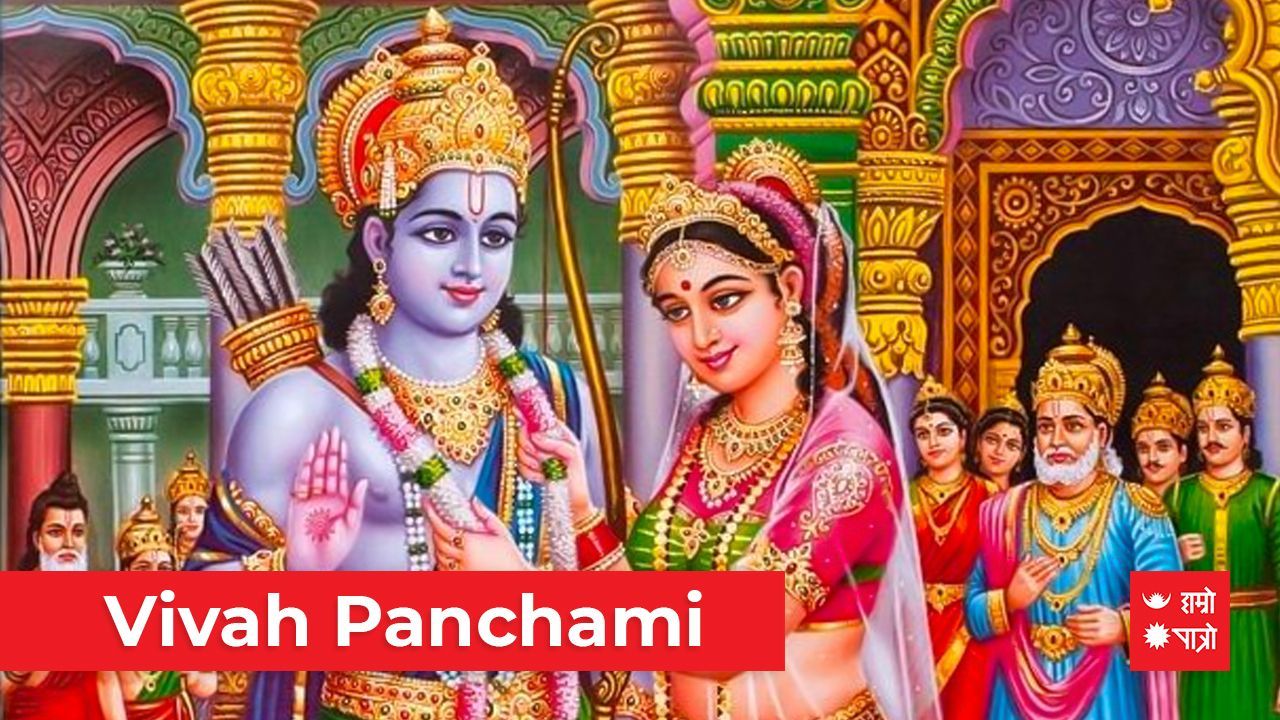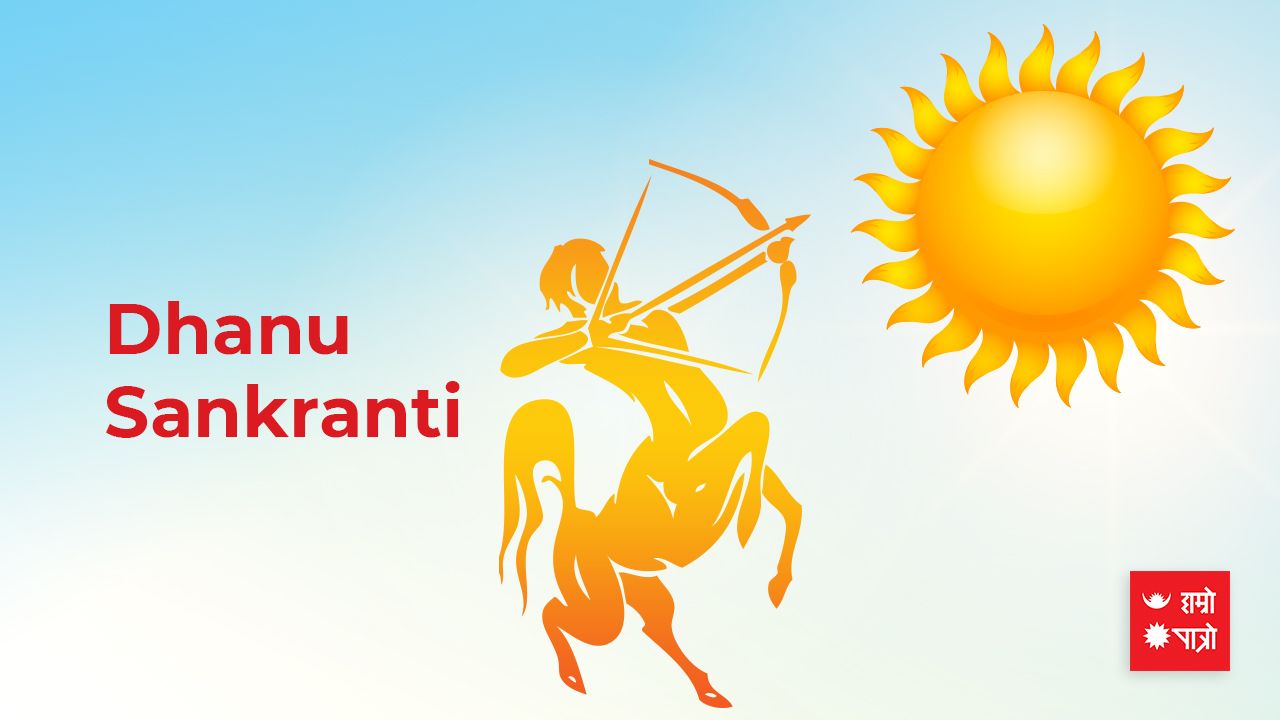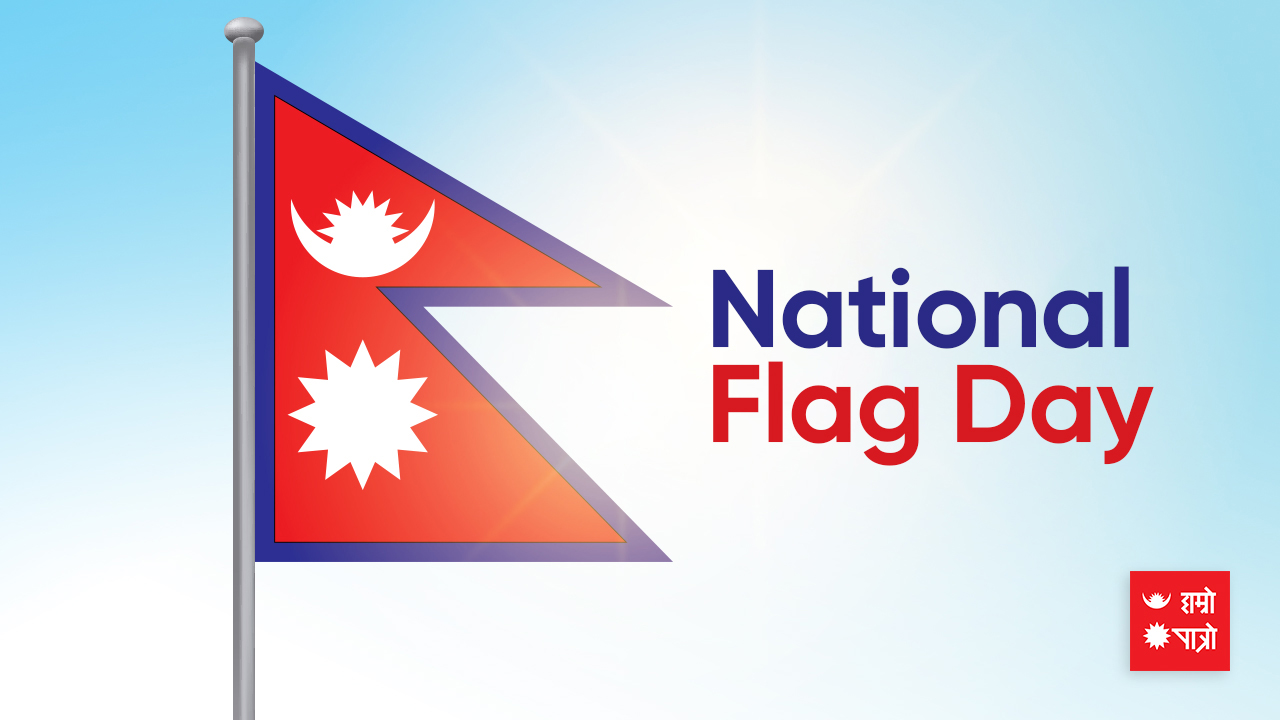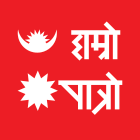Upcomming Events
-
29PaushNational Bhakka Day tomorrow
-
30PaushShattila Ekadashi 2 days remaning
-
1MaghMakar Sankranti/Ghiu chaku khane Din/Uttarayan Arambha 3 days remaning
-
2MaghNational Earthquake Safety Day/Pradosh Vrata 4 days remaning
-
5MaghSonam Lhochhar/Shree Ballav Jayanti 7 days remaning
-
8MaghTilkunda Chauthi 10 days remaning
-
9MaghBasanta Panchami vrata/Saraswati Pooja 11 days remaning
-
10MaghSkanda Sasti/Achala Saptami/International Day of Education 12 days remaning
-
11MaghGorakhkali Puja/World Leprosy Day 13 days remaning
-
12MaghInternational Custom Day 14 days remaning
-
13MaghDron Nawami 15 days remaning
-
15MaghBhima Ekadashi Vrata 17 days remaning
-
16MaghSahid Diwas/Pradosh Vrata 18 days remaning
-
18MaghShree Swasthani Brata Samapti/Poornima Wrata 20 days remaning
-
19MaghWorld Wetlands Day 21 days remaning
-
21MaghWorld Cancer Day 23 days remaning
-
25MaghRavisaptami Vrata 27 days remaning
-
26MaghGorakhkali Puja 28 days remaning
-
28MaghInternational Day of Women and Girls in Science/Safer Internet Day 30 days remaning
-
1FalgunKumbha Sankranti/Bijaya Ekadashi Vrata/World Radio Day 32 days remaning
-
2FalgunShani Pradosh Vrata/Valentine's Day 33 days remaning
-
3FalgunMaha-Shivaratri / Army Day/Silachahre Puja 34 days remaning
-
6FalgunGyalpo Lhosar 37 days remaning
-
7FalgunPrajatantra Diwas / Election Day 38 days remaning
-
8FalgunWorld Day of Social Justice 39 days remaning
-
9FalgunInternational Mother Language Day 40 days remaning
-
12FalgunBhaumashtami Wrata/Gorakhkali Puja 43 days remaning
-
15FalgunAmalaki Ekadashi Vrata/World NGO Day 46 days remaning
-
17FalgunPradosh Vrata/Zero Discrimination Day 48 days remaning
-
18FalgunFagu Poornima / Holi/Poornima Vrata 49 days remaning
-
19FalgunFagu Poornima (Terai)/Khandagras Chandra Grahan/World Wildlife Day 50 days remaning
-
20FalgunTel Lagaune Ra Aapko Mujura Khane Din 51 days remaning
-
24FalgunInternational Womens Day 55 days remaning
-
27FalgunGorakhkali Puja 58 days remaning
-
1ChaitraMeen Sankranti/Paapmochini Ekadashi Brata/World Consumer Rights Day 62 days remaning
-
2ChaitraSom Pradosh Vrata 63 days remaning
-
3ChaitraPahachahre 64 days remaning
-
4ChaitraGhode Jaatra 65 days remaning
-
5ChaitraTel Lagaune Ra Nimko Pat Khane Din 66 days remaning
-
6ChaitraWorld Oral Health Day/International Day of Happiness 67 days remaning
Jyotish
-
Jyotish Pandit Mukunda Nepalज्योतिष पण्डित मुकुन्द नेपाल�...
-
Jyotish Vaman Sapkotaशिक्षा - व्याकरणाचार्य, पौरोही...
-
 Jyotish Dharmendra Krishna Paudelशास्त्री धर्मेन्द्र कृष्ण पौ�...
Jyotish Dharmendra Krishna Paudelशास्त्री धर्मेन्द्र कृष्ण पौ�...
-
Jyotish Amrit Paudelवाराणसीकै सम्पूर्णानन्द संस्...
-
Jyotish Narayan Prasad Gautamगुरुकुल शिक्षा प्रणालीबाट ज्�...
-
Jyotish Purushottam Ghimireनेपाल संस्कृत विश्वविद्यालय, �...
-
Jyotish Damodar Kaushikज्योतिष र व्याकरण विषयमा आचार�...
-
Jyotish Mohan Ghimireसम्पुर्णानन्द संस्कृत विश्वव...
-
Jyotish Damodar Poudelनेपाल संस्कृत विश्व बिद्यालय�...
-
Jyotish Krishna Prasad Bhandariउपप्राध्यापक (Asst. professor of Sanskrit) नेपा�...
-
Jyotish Dipendra Khatiwadaसम्पुर्णानन्द संस्कृत बिश्वब...
-
Jyotish Khageshwor Subediगुरुकुल पद्दति बाट ज्योतिषीय �...
-
Jyotish Narayan Prasad Bhandariज्योतिषका उप-प्राध्यापक (lecturer of A...
-
Jyotish Smarika Acharyaबाल्मीकि बिद्यापिठ बाट ज्योत�...
-
Jyotish Hamro patroनेपाल संस्कृत विश्वविद्यालय �...
-
 Jyotish Mukunda Sharmaस्वाध्याय, सत्सङ्ग र सदाचारजस�...
Jyotish Mukunda Sharmaस्वाध्याय, सत्सङ्ग र सदाचारजस�...
-
 Jyotish Kuresh Pandey११ वर्षको अनुभवसहित विभिन्न ध�...
Jyotish Kuresh Pandey११ वर्षको अनुभवसहित विभिन्न ध�...
-
Jyotish Deepak Prasad Kafleसम्पूर्णानन्द संस्कृत विश्वव...
-
Jyotish Ghanashyam Pokharelनेपाल संस्कृत विश्वविद्यालयब...
मंसिर शुक्ल पञ्चमी
Vivah Panchami। Shadananda Jayanti । Dhanu Sankranti

अपहृत्य शचीं भार्यां शक्यमिन्द्रस्य जीवितुम् ।
नहि रामस्य भार्यां मामानीय स्वस्तिमान् भवेत् ॥
पूर्वोक्त, सर्ग ४८, छन्द २३०
On the contrary, Indra's wife Sachi can live happily, but no one who abducts the wife of the dignified Purushottam Ram can live happily, meaning that her destruction by Lord Rama is irrefutable.
And that's exactly what happened, Ramayana is an ideal love story, and love begins with the bond of marriage. The tithi of marriage is called Panchami. This sacred tithi from before history has special significance in the devotional path, Ram Sita is unbreakable and remains so.
Living Ramayana in Nepal
I have always stated that the Ramayana life is still alive in Nepal, especially in Mithila capital Janakpur of Nepal, Bibaha Panchami is a piece of evidence to it. Today, in the Treta era, it is believed that Prince Ram of Ayodhya came and married Princess Sita at Janakpur Dham, the capital of Mithila state. We would like to explain the wedding Panchami in the context of Ramayana of Treta era, Mansir Shukla Panchami i.e. today the marriage of Ardash Jodi Ram Sita took place in Janakpur of Nepal according to Vedic Sanatan Hindu culture.
In the weekly wedding celebration, Ramjan's wedding Panchami festival, devotees organize tilkotsav, matkor, and worship according to religious rituals, the Bibaha Panchami festival is formally concluded exactly like of typical marriage. That is why there is a myth that anyone should not look at the Sait (Auspicious date) when they get married on the day of Bibaha Panchami.
Janakpur is the birthplace of Sita. Sita or Janaki is the main character of Ramayana. Sita is the eldest daughter of King Janak, the ruler of Mithila kingdom. Ram is the eldest son of King Dasharatha of Ayodhya. Sita is an example of an ideal wife, an ideal mother, an ideal brother-in-law, an ideal daughter-in-law, an ideal queen, and an ideal woman in general.
Sita is revered as a source of virtue, femininity, motherhood, and compassion. Shiva used to move the bow, which was protected by King Janak, which could not be lifted even by the great heroes. Sita used to move the bow around alone while cleaning the shrine.
That is why King Janak had promised to do Sita's swayamvara only with a brave man who could lift Shiva's bow. The marriage of Sita and Rama was solemnized in Janakpur after the same Shiva bow was broken by Prince Ram of Ayodhya.
The wedding Panchami has been celebrated since that time. Sita's sisters Urmila, Mandvi, and Shrutakirti were also married to Rama's brothers Laxman, Bharat, and Shatrughan.
What happens at Janakpur, Capital of Mithila ?
The wedding ceremony is held in the afternoon, but since morning, the Ramjanki temple and other temples in the Mithila area are crowded with visitors. Bajagaja, jhanki, bhajan kirtan, and dance are performed in the festival, while the devotees who see the janti and dola are overwhelmed. After the Swayambar of Ram and Sita, the chariots carrying the bride and groom are taken on a procession including traditional music around Janakpur city and end at the Janaki temple area.
Even today, in remembrance of this ancient mythical marriage, it is customary to bring a janta from India to Janakpur, Nepal, and pay homage to the idols of Rama and Sita. In this way, Jantas coming from India are especially saints. Janakpur, a city rich in ponds, lakes, and beautiful Maithil culture, today looks full of divine beauty.
Even in this age, Ram Sita's marriage is as important as it was before. Today, a massive fair has been held at the Janaki temple premises and the people of Janakpur are continuing the tradition and intimacy they have been following since Tretayug.
Ramayana
The great Ramayana, which has 24,000 lines and 500 chapters, and seven sections, is the story of the ups and downs of the lives of Rama and Sita. The Ramayana, written by the sage Valmiki after the earlier Ratnakar bandit, is also very popular in Nepal, Sri Lanka, Thailand, Cambodia, Malaysia, and Indonesia. These lines of Ramayana were memorized by Rama's sons Love and Kush. After hearing the verses of Ramayana, Rama recognized his sons.
After Sita's ordeal, Ramayana has taken a different angle and turn. By teaching lessons on the importance of men and women, equality, family responsibilities, state policies, and dignity, Ramayana has given great value to the human community and civilization.
Let the stories and sayings of Sita and Rama go on for centuries.
Happy Bibaha Panchami to all.
Sadananda Jayanti
Who is guru Sadananda ?
Shadananda Adhikari, the famous social worker, and Brahmachari Sadhu and educationist of Nepal, i.e. Balaguru Shadananda was born on the day of Shukla Panchami (Vivah Panchami) in the year 1892 BS in Dingla, Gadigaun, Bhojpur district of Nepal. The child of father Laxmi Narayan Adhikari and mother Rukmini Adhikari, he became known as Brahmachari Guru Shadananda.
Even during the Rana regime, Guru Shadananda for the first time built a culture school and started an environment of learning for the children of the common people. Technically, this school was established long before schools like Durbar High school were established in the capital city.
Realizing the difficulties of gaining education, Shadananda devoted his entire life to promoting education in rural Nepal. Shadananda established himself as a practitioner of yoga, a practitioner of Ashtanga Yoga, and a connoisseur of Eastern philosophy through hard penance in his life. Shadananda, who acquired knowledge of Yajna rituals at the age of eight, studied yoga in Banaras, India.
Shadananda, who was believed by the people to have divine power, was later honored with the title of Shri 108. In his honor, a municipality in Bhojpur district in the Koshi zone has been named after Balaguru Shadananda. The post ticket is published in his name. The Brahmachari Shadananda Pratishthan honors Balaguru every year with the "Shadananda National Award" for outstanding contributions in the field of Nepali language, culture, history, and spiritual philosophy and literature.
His invaluable contribution to education will always be appreciated.
Dhanu Sakranti
Dhanu Sakranti or Dhanu Sankraman is the first day of Poush month. Dhanu Sakranti occurs when the sun crosses over to the zodiac sign Sagittarius which is known as the Dhanu Rashi. In a Hindu calendar year, the sun crosses over to different zodiac signs a total of twelve times. This phenomenon is called Sankranti. This means that there are twelve Sankratis in a year and the first day of a month is Sakranti.
Welcome to the ninth month of this year, Poush. This is the month with the shortest and coldest days and it commemorates Lord Jagannath and Lord Surya.
Lord Krishna proceeded to Mathura on this day, so this Sakranti also commemorates the importance of an initiation for righteousness.
The cold is at its peak, we got to take care of ourselves. This month is also called orangy month as the markets are filled with oranges. Enjoy the month, stay safe.
National Flag Day
When is National Flag Day celebrated?
National Flag Day is celebrated in Nepal every year on the 1st of Paush.
When did the National Flag Day begin to be celebrated?
The National Heritage Conservation Foundation (Rastriya Dharohar Samrakshan Pratisthan) has been celebrating this day since Poush 1st, 2077 B.S. This year is the sixth series of National Flag Day.
Why is National Flag Day celebrated?
The national flag of Nepal was adopted by the United Nations on 1st Paush 2019 B.S. In commemoration of the same day, the National Heritage Preservation Foundation has been celebrating it as a day since Paush 1, 2075 B.S.
Every year, the institution has been celebrating National Flag Day and National Dress Day and National Hat Day on different dates.
The day is celebrated with the aim of celebrating the national flag of Nepal. Today, the main message of this day is conveyed by organizing various programs across the country, including the message of reawakening nationalism and love for the nation.
The importance of the national flag should always remain unshakable. Jai Jai Jai Nepal.
-Suyog Dhakal
Upcomming Events
-
29PaushNational Bhakka Day tomorrow
-
30PaushShattila Ekadashi 2 days remaning
-
1MaghMakar Sankranti/Ghiu chaku khane Din/Uttarayan Arambha 3 days remaning
-
2MaghNational Earthquake Safety Day/Pradosh Vrata 4 days remaning
-
5MaghSonam Lhochhar/Shree Ballav Jayanti 7 days remaning
-
8MaghTilkunda Chauthi 10 days remaning
-
9MaghBasanta Panchami vrata/Saraswati Pooja 11 days remaning
-
10MaghSkanda Sasti/Achala Saptami/International Day of Education 12 days remaning
-
11MaghGorakhkali Puja/World Leprosy Day 13 days remaning
-
12MaghInternational Custom Day 14 days remaning
-
13MaghDron Nawami 15 days remaning
-
15MaghBhima Ekadashi Vrata 17 days remaning
-
16MaghSahid Diwas/Pradosh Vrata 18 days remaning
-
18MaghShree Swasthani Brata Samapti/Poornima Wrata 20 days remaning
-
19MaghWorld Wetlands Day 21 days remaning
-
21MaghWorld Cancer Day 23 days remaning
-
25MaghRavisaptami Vrata 27 days remaning
-
26MaghGorakhkali Puja 28 days remaning
-
28MaghInternational Day of Women and Girls in Science/Safer Internet Day 30 days remaning
-
1FalgunKumbha Sankranti/Bijaya Ekadashi Vrata/World Radio Day 32 days remaning
-
2FalgunShani Pradosh Vrata/Valentine's Day 33 days remaning
-
3FalgunMaha-Shivaratri / Army Day/Silachahre Puja 34 days remaning
-
6FalgunGyalpo Lhosar 37 days remaning
-
7FalgunPrajatantra Diwas / Election Day 38 days remaning
-
8FalgunWorld Day of Social Justice 39 days remaning
-
9FalgunInternational Mother Language Day 40 days remaning
-
12FalgunBhaumashtami Wrata/Gorakhkali Puja 43 days remaning
-
15FalgunAmalaki Ekadashi Vrata/World NGO Day 46 days remaning
-
17FalgunPradosh Vrata/Zero Discrimination Day 48 days remaning
-
18FalgunFagu Poornima / Holi/Poornima Vrata 49 days remaning
-
19FalgunFagu Poornima (Terai)/Khandagras Chandra Grahan/World Wildlife Day 50 days remaning
-
20FalgunTel Lagaune Ra Aapko Mujura Khane Din 51 days remaning
-
24FalgunInternational Womens Day 55 days remaning
-
27FalgunGorakhkali Puja 58 days remaning
-
1ChaitraMeen Sankranti/Paapmochini Ekadashi Brata/World Consumer Rights Day 62 days remaning
-
2ChaitraSom Pradosh Vrata 63 days remaning
-
3ChaitraPahachahre 64 days remaning
-
4ChaitraGhode Jaatra 65 days remaning
-
5ChaitraTel Lagaune Ra Nimko Pat Khane Din 66 days remaning
-
6ChaitraWorld Oral Health Day/International Day of Happiness 67 days remaning
Jyotish
-
Jyotish Pandit Mukunda Nepalज्योतिष पण्डित मुकुन्द नेपाल�...
-
Jyotish Vaman Sapkotaशिक्षा - व्याकरणाचार्य, पौरोही...
-
 Jyotish Dharmendra Krishna Paudelशास्त्री धर्मेन्द्र कृष्ण पौ�...
Jyotish Dharmendra Krishna Paudelशास्त्री धर्मेन्द्र कृष्ण पौ�...
-
Jyotish Amrit Paudelवाराणसीकै सम्पूर्णानन्द संस्...
-
Jyotish Narayan Prasad Gautamगुरुकुल शिक्षा प्रणालीबाट ज्�...
-
Jyotish Purushottam Ghimireनेपाल संस्कृत विश्वविद्यालय, �...
-
Jyotish Damodar Kaushikज्योतिष र व्याकरण विषयमा आचार�...
-
Jyotish Mohan Ghimireसम्पुर्णानन्द संस्कृत विश्वव...
-
Jyotish Damodar Poudelनेपाल संस्कृत विश्व बिद्यालय�...
-
Jyotish Krishna Prasad Bhandariउपप्राध्यापक (Asst. professor of Sanskrit) नेपा�...
-
Jyotish Dipendra Khatiwadaसम्पुर्णानन्द संस्कृत बिश्वब...
-
Jyotish Khageshwor Subediगुरुकुल पद्दति बाट ज्योतिषीय �...
-
Jyotish Narayan Prasad Bhandariज्योतिषका उप-प्राध्यापक (lecturer of A...
-
Jyotish Smarika Acharyaबाल्मीकि बिद्यापिठ बाट ज्योत�...
-
Jyotish Hamro patroनेपाल संस्कृत विश्वविद्यालय �...
-
 Jyotish Mukunda Sharmaस्वाध्याय, सत्सङ्ग र सदाचारजस�...
Jyotish Mukunda Sharmaस्वाध्याय, सत्सङ्ग र सदाचारजस�...
-
 Jyotish Kuresh Pandey११ वर्षको अनुभवसहित विभिन्न ध�...
Jyotish Kuresh Pandey११ वर्षको अनुभवसहित विभिन्न ध�...
-
Jyotish Deepak Prasad Kafleसम्पूर्णानन्द संस्कृत विश्वव...
-
Jyotish Ghanashyam Pokharelनेपाल संस्कृत विश्वविद्यालयब...
Liked by:


















 Mesh
Mesh Brish
Brish Mithun
Mithun Karkat
Karkat  Singha
Singha  Kanya
Kanya Tula
Tula Brischik
Brischik Dhanu
Dhanu  Makar
Makar  Kumbha
Kumbha Meen
Meen